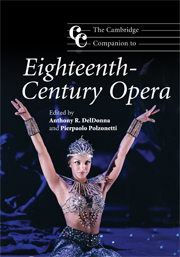Book contents
- Frontmatter
- Part I The making of opera
- 1 Opera as process
- 2 Aria as drama
- 3 Ensembles and finales
- 4 Metastasio: the dramaturgy of eighteenth-century heroic opera
- 5 Roles and acting
- 6 Ballet
- 7 Orchestra and voice in eighteenth-century Italian opera
- 8 To look again (at Don Giovanni)
- Part II National styles and genres
- Notes
- Bibliography
- Index
7 - Orchestra and voice in eighteenth-century Italian opera
from Part I - The making of opera
Published online by Cambridge University Press: 28 September 2011
- Frontmatter
- Part I The making of opera
- 1 Opera as process
- 2 Aria as drama
- 3 Ensembles and finales
- 4 Metastasio: the dramaturgy of eighteenth-century heroic opera
- 5 Roles and acting
- 6 Ballet
- 7 Orchestra and voice in eighteenth-century Italian opera
- 8 To look again (at Don Giovanni)
- Part II National styles and genres
- Notes
- Bibliography
- Index
Summary
Instruments and voices
Before the eighteenth century the orchestra rarely accompanied singers in Italian opera. Solo singing in seventeenth-century operas was characteristically accompanied by the continuo group of harpsichord, plucked instruments and bass. The orchestra of bowed strings usually played only when no one was singing: for entrances and exits, between vocal numbers, for dancing and other stage business. Arias accompanied by the continuo group (“continuo arias”) were often followed by a short orchestral ritornello, confirming the final cadence of each stanza and giving the singer a chance to leave the stage at the end. Continuo accompaniment was the “neutral” scoring, whereas accompaniment by the larger orchestra marked an aria or a recitative as special. Sometimes it indicated heightened emotion; sometimes it signified a stereotypical dramatic situation – a royal entrance, a boast or a challenge, a lover's plea, a lament. Around the beginning of the eighteenth century, however, composers began to give orchestral accompaniments to more and more arias, and by the 1720s continuo arias had become rather rare.
The new, more orchestral style of accompaniment was characteristic of operas by composers like Sarri, Vinci, Pergolesi, Leo, and Hasse. Arias by these composers typically begin with an orchestral ritornello; when the voice enters, the orchestra goes on playing along with the continuo. Accompaniment by an orchestra of strings has become the neutral scoring. Now it took something more to mark an aria as special – wind instruments, an instrumental solo, pizzicato, or some other special effect. Recitative was accompanied, as before, primarily by the continuo group, with orchestral accompaniment reserved for special moments.
- Type
- Chapter
- Information
- The Cambridge Companion to Eighteenth-Century Opera , pp. 112 - 139Publisher: Cambridge University PressPrint publication year: 2009



